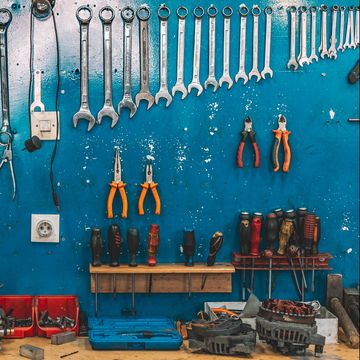The 2015 Ford F-150's aluminum body is a big deal, but there might be even more innovation under the hood. The twin-turbocharged EcoBoost 2.7-liter V-6 is full of tricks, such as reducing overall mass by using iron and aluminum only where each metal's properties are most beneficial. The result is more than 300 hp in an extremely compact and lightweight design.
A. Upper Block
The most novel element of this engine is the two-piece block, with a single iron casting for the upper block, which includes the cylinders, and the main bearing caps (only the lower half of the block is aluminum). The bearing caps are laser etched and then cracked off to fit the crankshaft. Once reassembled, the three-dimensional mating surface for each cap provides extra stability. The match is so good that Ford has tested engines running without the caps bolted in at all.
B. Lower Block
Most engine blocks are made from a single material, but to save weight the 2.7-liter's lower ladder frame is die-cast aluminum and bolts onto the iron upper half. A second set of bolts secures the bearing caps to the ladder frame to further stiffen the engine. A composite oil pan seals up the bottom.
C. Integrated Front Cover
The IFC (no, not the cable channel) acts as a structural member that connects the major components of the engine. With its integrated water pump, oil passages for cam phasing, oil cooler, oil filter, and accessory drive components, the IFC arrives at the plant preassembled, streamlining the production process.
D. Piston Rods
Piston connecting rods have two ends—a big end that connects to the crankshaft and a small end that connects to the piston. The small end normally has a bushing, but Ford eliminated this by honing the wrist-pin hole and applying a high-durability coating along with optimizing the shape for better oil distribution. Removing the bushing not only saves money but also reduces the engine's overall height.
E. Piston-Ring Seats
There is a steel insert in each aluminum piston for the top oil ring to improve durability—a trick swiped from semi-truck engines. The engine also uses a tactic often seen in F1: Small holes in the lowest ring seats allow oil to escape to the crankcase, which minimizes drag from oil buildup at high speeds.
Stop/Start
This will be the first Ford truck engine with automatic stop/start capability. To prevent durability problems resulting from oil starvation every time the engine starts,a proprietary friction-reducing coating is applied to the main bearing races. A lifetime-wear test using dirty oil revealed almost no abrasion on the coated surface.













